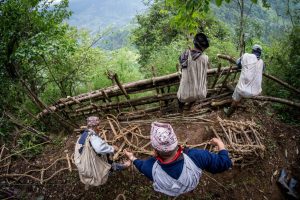Honey Hunting in Nepal: Mad Honey & Ancient Traditions
Hidden in the rugged cliffs and remote valleys of the Himalayas, Honey Hunting in Nepal is an ancient ritual unlike any other. This daring tradition blends adventure, culture, and the intoxicating allure of mad honey, a potent nectar famed for its mind-altering effects. From the steep rock faces of Annapurna to the dense forests of Lamjung, wild honey hunting in Nepal draws travelers eager to witness fearless Gurung hunters scale dizzying heights to harvest the world’s rarest honey. Whether you’re fascinated by the legends of Himalayan mad honey or simply seeking a glimpse into Nepal’s vanishing traditions, this journey offers a window into a living heritage few outsiders ever experience.
What is Honey Hunting in Nepal?
Honey hunting in Nepal is an ancient and adrenaline-charged tradition practiced mainly by Gurung, Magar, and Rai communities. Imagine dangling on handmade rope ladders from sheer 300-foot cliffs as thousands of giant Himalayan bees swarm around you.
Twice a year, local hunters trek deep into remote gorges to harvest wild honeycomb from the Apis laboriosa, the world’s largest honeybee. These bees produce the legendary mad honey, a golden nectar prized both as a delicacy and a traditional medicine.
“It’s not just about honey, it’s about honoring mountain spirits and passing down ancestral knowledge.”

Hunter climbing a cliff for Mad Honey
Where Does Honey Hunting Happen?
The most famous honey hunting destinations in Nepal include:
- Annapurna region (Lamjung, Ghandruk, and Bhujung)
- Kaski District near Pokhara
- Gorkha and Dhading districts
These are rugged landscapes where rhododendron forests cling to cliffs and villagers still follow centuries-old rituals.
Tip: If you’re looking for the most accessible honey hunting tour in Nepal, Annapurna honey hunting expeditions are popular and relatively easier to reach.
Rituals and Cultural Significance
Before the harvest, hunters perform elaborate ceremonies to appease the cliff gods and ensure safety. They offer:
- Rice, flowers, and incense
- Animal sacrifices in some communities
- Chants and prayers led by village elders
This ritual reflects a profound respect for nature and ancestral spirits, without it, no one dares to begin.

Ladder used by hunters for Mad Honey Hunting
Mad Honey: Nepal’s Wild Psychedelic Nectar
What makes this honey so famous (and infamous) is its intoxicating power. Mad honey, locally called del or red honey, comes from bees feeding on rhododendron flowers rich in grayanotoxins.
Mad Honey Effects
- Small doses: Relaxation, mild euphoria
- Larger doses: Dizziness, blurred vision, hallucinations
- Overdose: Nausea, dangerously low blood pressure
For centuries, locals have used mad honey from Nepal to treat hypertension, digestive issues, and even as an aphrodisiac. Today, travelers are drawn by curiosity, just remember moderation is key!
Annapurna Honey Hunting: A Trekker’s Paradise
Among all honey hunting destinations, Annapurna honey hunting is the most famous. The region offers:
- Stunning backdrops of Annapurna and Machapuchare
- Rich Gurung culture
- Opportunities to combine the trek with village tours and other side trails
If you’re planning a honey hunting tour in Nepal, this is the perfect blend of adventure, scenery, and tradition.
You can also opt for our Annapurna Panorama with Barang Community Homestay package for similar cultural experience.

Villagers carrying rope for making ladder
Conservation and Challenges
Honey hunting faces serious threats:
- Climate change disrupting bee cycles
- Logging and deforestation destroying habitats
- Younger generations migrating to cities
Many communities now limit harvests to protect bee populations. Responsible tourism helps sustain these traditions—choose operators committed to conservation.
The Honey Hunting Tour Experience
Honey hunting tours blend trekking, cultural immersion, and the thrill of witnessing the harvest. Most trips include:
- Trekking to remote cliff sites
- Homestays in traditional villages
- Participating in pre-hunt rituals
- Watching skilled hunters ascend cliffs with bamboo ladders
- Tasting freshly collected Himalayan mad honey
Depending on the region, tours range from 3 to 7 days, often starting in Pokhara and requiring moderate fitness.

Hunters assembling rope ladder for Honey Hunting
How to Prepare for a Honey Hunting Tour
Fitness Level: Moderate—expect uphill trekking and rough trails
Best Time: Spring (April–May) and Autumn (October–November)
Gear: Good hiking boots, lightweight clothing, rain jacket, camera, and personal medication
Caution: If you plan to taste mad honey, start with small amounts under local guidance.
Also read our latest blog on Solo Trekking Along Hidden Trails of Kori Kapuche Lake Trek.
FAQs
1: What is mad honey and why is it special?
Mad honey is produced by Himalayan giant bees from rhododendron nectar. It contains grayanotoxins that cause mild hallucinations in larger quantities.
2: Is honey hunting safe to observe?
Yes. Tourists stay at a safe distance while guides handle safety procedures.
3: Can I bring mad honey home?
In small quantities, yes, check your country’s import regulations.
4: When is the best season for honey hunting tours?
April–May and October–November are the traditional harvest windows.
5: Where can I book a reliable honey hunting tour?
Specialized operators in Pokhara and Kathmandu organize responsible tours, often in partnership with local communities.
Conclusion
Honey Hunting in Nepal is more than an adventure, it’s a living testament to courage, tradition, and the mysteries of the Himalayas. Whether you go to taste the fabled mad honey or simply watch the spectacle, this journey will stay etched in your memory.
If you’re planning to witness this once-in-a-lifetime experience, do so with respect for the communities who have kept this art alive for generations.
Contact Red Reach Himalaya today and explore the best packages for the Chisapani Nagarkot Trek.
No matter if you are seeking easy trek in Nepal, adventure trekking or cultural blend of it all; Let Red Reach Himalaya guide you on your trip.











